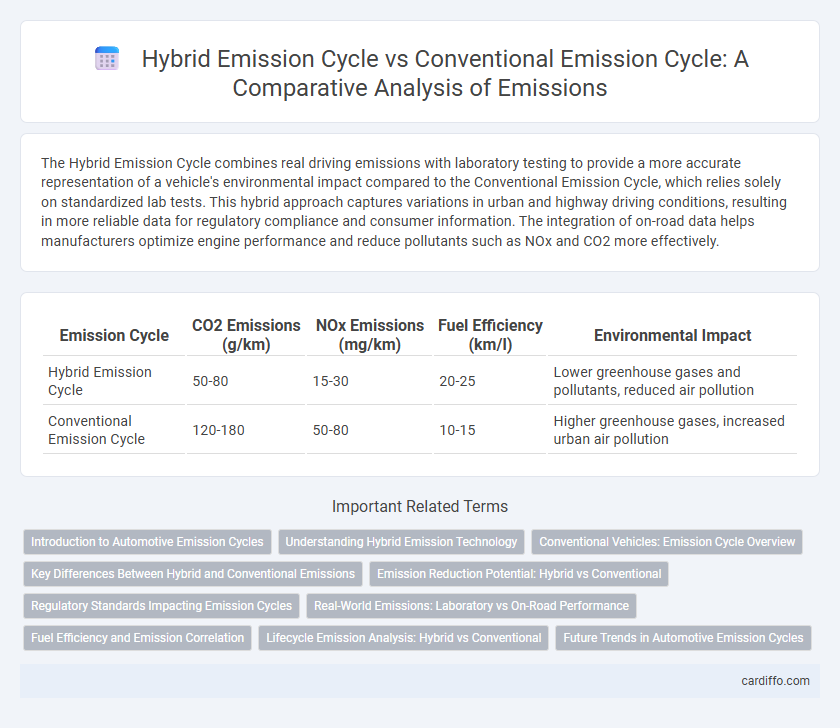The Hybrid Emission Cycle combines real driving emissions with laboratory testing to provide a more accurate representation of a vehicle's environmental impact compared to the Conventional Emission Cycle, which relies solely on standardized lab tests. This hybrid approach captures variations in urban and highway driving conditions, resulting in more reliable data for regulatory compliance and consumer information. The integration of on-road data helps manufacturers optimize engine performance and reduce pollutants such as NOx and CO2 more effectively.
Table of Comparison
| Emission Cycle | CO2 Emissions (g/km) | NOx Emissions (mg/km) | Fuel Efficiency (km/l) | Environmental Impact |
|---|---|---|---|---|
| Hybrid Emission Cycle | 50-80 | 15-30 | 20-25 | Lower greenhouse gases and pollutants, reduced air pollution |
| Conventional Emission Cycle | 120-180 | 50-80 | 10-15 | Higher greenhouse gases, increased urban air pollution |
Introduction to Automotive Emission Cycles
Hybrid emission cycles combine elements of both urban and extra-urban driving conditions to more accurately represent real-world automotive emissions, unlike conventional emission cycles which often rely on fixed-speed tests. These hybrid cycles integrate variable speeds, idling periods, and acceleration phases to capture a broader range of pollutant emissions such as NOx, CO, and particulate matter. Employing hybrid emission cycles enables regulatory bodies and manufacturers to better assess vehicle performance and compliance with stringent environmental standards.
Understanding Hybrid Emission Technology
Hybrid emission technology integrates both conventional internal combustion engine cycles and electric propulsion systems to reduce overall emissions and improve fuel efficiency. By combining the strengths of the conventional emission cycle with electric motor assistance, hybrid systems significantly lower pollutants such as NOx, CO2, and particulate matter during urban driving and stop-and-go conditions. This technology enables optimized engine performance and regenerative braking, resulting in a cleaner and more sustainable emission profile compared to traditional vehicle emission cycles.
Conventional Vehicles: Emission Cycle Overview
Conventional emission cycles in internal combustion engine vehicles primarily rely on the New European Driving Cycle (NEDC) or the Worldwide Harmonized Light Vehicles Test Procedure (WLTP) to measure pollutants such as CO2, NOx, and particulate matter. These cycles simulate standardized driving conditions to assess fuel consumption and exhaust emissions under urban and highway scenarios. Emission outputs from conventional vehicles remain a major contributor to air pollution due to the combustion of fossil fuels without energy recovery mechanisms.
Key Differences Between Hybrid and Conventional Emissions
Hybrid emission cycles integrate both electric and internal combustion engine outputs, resulting in significantly lower CO2 and NOx emissions compared to conventional emission cycles relying solely on fossil fuel combustion. Advanced emission control technologies in hybrid vehicles, such as regenerative braking and start-stop systems, reduce particulate matter and unburned hydrocarbons more effectively than traditional engines. Conventional emission cycles typically produce higher greenhouse gases and pollutants due to continuous fuel combustion without intermittent engine shutdowns or electric motor assistance.
Emission Reduction Potential: Hybrid vs Conventional
Hybrid emission cycles demonstrate significantly higher emission reduction potential compared to conventional emission cycles by combining electric motor assistance with internal combustion engines, effectively lowering tailpipe pollutants such as CO2, NOx, and particulate matter. The integration of regenerative braking and optimized engine load management in hybrids leads to improved fuel efficiency and a decrease in overall greenhouse gas emissions by up to 30-50%. Conventional emission cycles rely solely on combustion engines, resulting in consistently higher emissions and limited capability to reduce environmental impact.
Regulatory Standards Impacting Emission Cycles
Hybrid emission cycles integrate both urban and highway driving conditions to meet more stringent regulatory standards such as Euro 6 and EPA Tier 3, resulting in reduced overall pollutant output compared to conventional emission cycles. These updated regulatory frameworks demand lower limits for nitrogen oxides (NOx), particulate matter (PM), and carbon monoxide (CO), compelling manufacturers to adapt hybrid emission testing protocols. Compliance with these standards significantly influences vehicle design, fuel efficiency strategies, and the implementation of advanced after-treatment systems to achieve cleaner emissions.
Real-World Emissions: Laboratory vs On-Road Performance
Hybrid Emission Cycles demonstrate significantly lower real-world emissions compared to Conventional Emission Cycles, particularly in on-road driving conditions where variable speeds and frequent stop-start patterns prevail. Laboratory tests often underestimate emissions for conventional engines due to their steady-state operation, while hybrid systems benefit from regenerative braking and electric motor assist, reducing pollutants such as NOx and CO2. Real-world data consistently shows hybrid vehicles achieving better compliance with stringent emission standards, highlighting the gap between controlled test environments and actual driving scenarios.
Fuel Efficiency and Emission Correlation
Hybrid emission cycles utilize regenerative braking and electric motor assistance to reduce fuel consumption, leading to lower carbon dioxide emissions compared to conventional emission cycles. Conventional engines rely solely on internal combustion, which results in higher fuel use and increased emissions of nitrogen oxides (NOx) and particulate matter. The integration of electric power in hybrid systems optimizes fuel efficiency and directly correlates with a significant reduction in greenhouse gases and urban air pollutants.
Lifecycle Emission Analysis: Hybrid vs Conventional
Lifecycle emission analysis reveals that hybrid emission cycles significantly reduce total greenhouse gas emissions compared to conventional cycles by optimizing fuel consumption and integrating regenerative braking systems. Conventional emission cycles generally exhibit higher lifecycle emissions due to reliance on fossil fuels and less efficient combustion processes. Strategic adoption of hybrid technologies can lower carbon footprints over the vehicle's operational life through improved energy efficiency and reduced tailpipe emissions.
Future Trends in Automotive Emission Cycles
Hybrid emission cycles integrate electric and combustion powertrains to significantly reduce greenhouse gas emissions compared to conventional emission cycles that rely solely on internal combustion engines. Advancements in battery technology and energy recovery systems are driving future trends toward more efficient hybrid emission cycles, enabling lower carbon footprints and compliance with increasingly stringent environmental regulations. Emerging innovations in sensor technology and real-time emission monitoring further optimize these cycles, shaping the future landscape of automotive emission reduction strategies.
Hybrid Emission Cycle vs Conventional Emission Cycle Infographic

 cardiffo.com
cardiffo.com